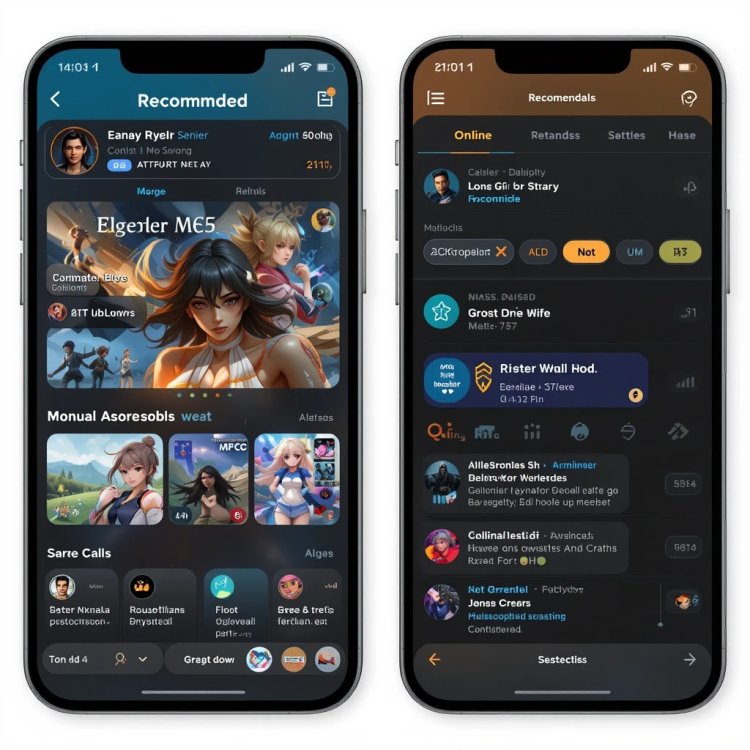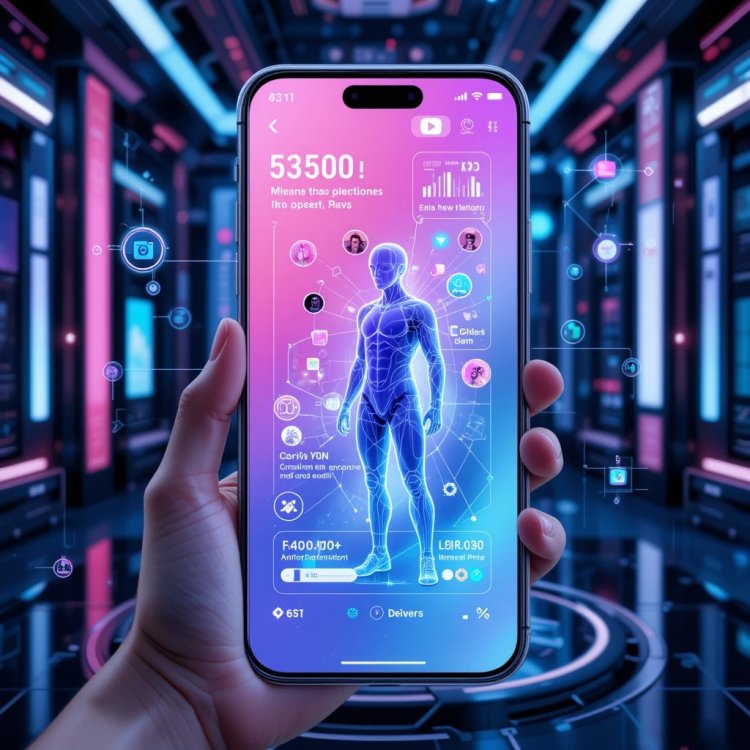Top 5 Mobile App Design Trends That Will Dominate in 2025
Stay ahead of mobile app design trends in 2025 with key elements like minimalist interfaces, dark mode, voice-activated controls, augmented reality (AR), and personalized experiences. Learn how these trends can enhance user engagement and retention, making your app stand out in a competitive market.
Share this Post to earn Money ( Upto ₹100 per 1000 Views )
Mobile app design is constantly evolving. As technology advances and user preferences shift, the designs that dominate the market are continuously changing. If you want your app to stand out in 2025, you need to stay ahead of the trends. So, what are the design elements that will define the mobile apps of the future?
In this post, we’ll explore the top 5 mobile app design trends that are expected to rule 2025 and beyond. From minimalist aesthetics to augmented reality (AR) integration, these trends aren’t just about looking good – they’re about enhancing the user experience and improving engagement. Let's dive in!
Introduction: The Evolving Mobile App Landscape
Why Mobile App Design Matters More Than Ever
The mobile app market is booming, with millions of apps available across platforms. But with so many options, how do you ensure that your app stands out from the crowd? The answer lies in design.
Great mobile app design doesn’t just make an app visually appealing; it plays a crucial role in user experience (UX), influencing how easy it is for users to interact with your app, how intuitive it feels, and whether users keep coming back. In 2025, the stakes will be higher than ever. As users demand more personalization, seamless interactions, and even more innovative features, app design must evolve to meet these expectations.
Trend 1: Minimalism and Simplified User Interfaces
The Power of Less
In 2025, less will truly be more. Minimalist design has been steadily rising in popularity, and it’s expected to dominate mobile apps next year. The focus will shift from overwhelming interfaces with complex features to streamlined, intuitive designs that prioritize what truly matters.
Minimalism isn’t just about removing clutter – it’s about creating a clear and user-friendly layout that guides users naturally through the app. Think fewer buttons, cleaner navigation, and more focus on essential features.
How Simplicity Drives Engagement
Minimalist design isn’t just about looks; it impacts how users interact with the app. With simpler, well-organized designs, users can find what they’re looking for faster, leading to higher user engagement and lower bounce rates. It makes everything feel more intuitive, which results in a better overall user experience.
Real-Life Examples
Look at apps like Google Keep or Apple’s Notes app – their simplicity and clean interfaces are easy to navigate, helping users stay focused on their tasks. This trend will continue to shape mobile apps in 2025 as businesses aim for clear and effective communication with their users.
Trend 2: Dark Mode as the New Standard
Why Users Love Dark Mode
Dark mode is no longer just a feature – it’s becoming the standard for most apps. Users love it because it’s easier on the eyes, especially in low-light environments, and it saves battery life on OLED screens.
In 2025, more apps will default to dark mode as the primary interface while giving users the option to switch to light mode when they prefer. As user experience becomes a top priority, providing options for comfort will be key.
Designing for Accessibility in Dark Mode
When designing for dark mode, it's crucial to ensure legibility and contrast. Text and buttons need to stand out clearly against the dark background. Designers will need to pay extra attention to colors and readability to ensure that accessibility isn’t compromised.
Trend 3: Voice-Activated Interfaces
The Rise of Voice Search and Commands
With the increasing use of voice assistants like Siri, Alexa, and Google Assistant, voice-controlled apps are becoming increasingly popular. In 2025, voice-activated interfaces will take app design to the next level, allowing users to interact with apps without even touching their screens.
Voice commands can streamline tasks, especially when multitasking or using mobile apps on the go. Think about how great it would be to place an order on your favorite food delivery app, or adjust settings on your smart home app, all with a simple voice command.
How Voice UI Can Transform User Experience
Designing for Voice User Interface (VUI) presents unique challenges, but it also creates opportunities for a more immersive experience. Mobile apps will integrate natural language processing (NLP) to allow users to control the app with everyday conversation, improving both convenience and accessibility.
Trend 4: Augmented Reality (AR) Integration
AR Enhances User Interaction
Augmented Reality (AR) will continue to be a major trend in 2025. From shopping to entertainment, AR helps create highly interactive and immersive experiences. Think virtual try-ons in fashion apps or interactive maps in travel apps – the possibilities are endless.
AR makes apps feel more engaging and personal, allowing users to interact with the app in a more dynamic way. Whether it’s previewing how a new piece of furniture looks in your living room or trying on a pair of virtual shoes, AR adds a layer of fun and functionality to your app.
From Games to Practical Uses: The AR Revolution
While gaming apps like Pokémon GO showcased the potential of AR, the trend is expanding into more practical industries. For instance, IKEA’s app lets customers visualize furniture in their homes before buying, and real estate apps use AR to provide virtual tours of homes. In 2025, more industries will adopt AR for practical applications, making it a must-have feature in mobile app design.
Case Studies of AR in Mobile Apps
Apps like Snapchat and Instagram already use AR filters and effects to enhance social media content. In 2025, expect more apps to incorporate AR to deliver innovative customer experiences that go beyond entertainment.
Trend 5: Customization and Personalization
Why Personalization is Key to User Retention
Personalized experiences are becoming increasingly important to users. By customizing content and features based on a user’s preferences, behaviors, and location, apps can create highly relevant and engaging interactions.
In 2025, users will expect apps to adapt to their individual needs, whether it’s tailored recommendations, personalized notifications, or custom themes. This hyper-personalization will drive user retention, making them feel more connected to the app and brand.
Creating Customizable User Experiences
One of the best ways to keep users engaged is by allowing them to customize their app experience. For example, apps can offer personalized dashboards, color themes, or widgets that allow users to make the app feel like their own. This level of customization will be crucial to maintaining loyalty in 2025 and beyond.
Conclusion: What This Means for the Future of App Design
The mobile app design trends we’ll see in 2025 are all about improving the user experience. By focusing on simplicity, accessibility, interactivity, and personalization, businesses can create apps that not only look great but also provide real value to users. The key to success will be ensuring that apps are user-friendly, intuitive, and able to keep up with evolving technology.
If you're looking to stay ahead of the curve and create a mobile app that embodies these trends, partnering with an experienced development team like Websenor can help turn your ideas into reality. With a focus on cutting-edge design and seamless user experience, Websenor can help you build the app of the future.
FAQs
1. How can dark mode improve my app’s user experience?
Dark mode enhances readability in low-light conditions, saves battery life on OLED screens, and offers a modern look that users love.
2. Why is minimalist design so important in 2025?
Minimalist design focuses on clean, intuitive interfaces, making apps easier to navigate and more engaging for users.
3. How can I incorporate voice commands into my app?
Voice-controlled features can be added to your app using natural language processing (NLP) technology, which allows users to interact with your app using simple voice commands.
4. What industries will benefit the most from AR in mobile apps?
Industries like retail, real estate, education, and gaming are already using AR, and other sectors will follow as AR technology becomes more accessible and affordable.
5. How can I personalize my app to improve user retention?
By customizing content, notifications, and UI elements based on user preferences, behaviors, and location, you can create a more engaging experience that keeps users coming back.
















![Hempified CBD Gummies - [Consumer Exposed] Does It ReallyWork?](https://blog.rackons.in/uploads/images/202505/image_380x226_682d61c2037fc.jpg)


